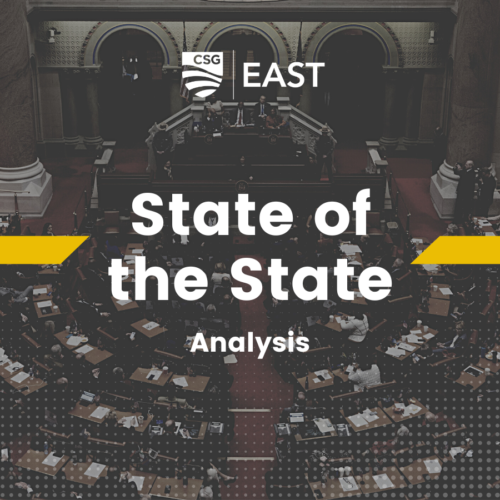NY Gov. Cuomo Announces Deal to Close Indian Point Nuclear Plant
The Indian Point Nuclear Plant will close in four years, more than a decade ahead of schedule, a deal that “eliminates a major risk” to the safety of New Yorkers, Gov. Andrew Cuomo announced in his State of the State address in Lower Manhattan on Monday.
The plant is located less than 30 miles from Midtown Manhattan, and Cuomo has long advocated for its closure, noting that in the event of an accident, evacuation would be all but impossible for the more than 20 million people who reside in New York City and its surrounding areas.
“New York City sits 30 miles from a ticking time bomb,” said Cuomo during the address. “This agreement eliminates a major risk, and provides welcome relief. New Yorkers can sleep a little better.”
The deal between the state and Entergy, the plant’s operator, calls for the reactor to shut down by April 2021, fourteen years ahead of schedule. An Entergy official told the The New York Times the company had assented to closing the plant early because cheap, abundant natural gas had made nuclear power less profitable.
Some industry sources questioned how the state would replace the 2,000 megawatts of power produced by the plant, which supplies about a quarter of the electricity used by New York City and Westchester County, while meeting the state’s carbon-reduction goals and its requirement that utilities get half of their power from renewable sources by 2030. Some experts expressed skepticism that the power could be replaced without relying on large quantities of natural gas.
Cuomo said the state had identified replacement sources of power for Indian Point, including investing in renewable energy.
The governor has prioritized investments in renewables as part of his administration’s energy-system overhaul, Reforming the Energy Vision, or REV, which was launched in 2014. The state has established a number of incentive programs and financing vehicles, including a 10-year, $5 billion Clean Energy Fund and a $1 billion New York Green Bank, a state-sponsored entity that was launched to partner with private-sector lenders to support renewable-energy projects.
New York has also pledged to lower its carbon emissions 40% below 1990 levels by 2030, and 80% by 2050. The state participates in the nine-state Regional Greenhouse Gas Initiative (RGGI), which caps emissions from large power plants. In his address on Monday, Cuomo said that New York would reduce its RGGI cap by 30% by 2030.
In a statement on the Indian Point closure plan that provides some details on replacement power options, the governor said that transmission upgrades and efficiency measures have already produced over 700 megawatts of power, and that several new sources of generation are fully permitted and readily available to come online by 2021, after the plant’s closure, including up to 1,000 megawatts of hydropower.
In his speech, Cuomo specifically mentioned plans to invest in offshore wind, and to add new transmission lines to deliver large quantities of hydropower from Québec.
Here is a brief overview of efforts related to those energy sources in New York, and elsewhere in the region.
Offshore Wind
Cuomo is among several officials in the Northeast who have been working to establish a thriving offshore wind industry here, though the sector is in its infancy in the U.S., with only one project currently in operation, a 30-megawatt pilot off the coast of Block Island, Rhode Island. That project went online in December. Although other projects are in the early stages of development up and down the Eastern Seaboard, it is expected to take several years, or even a decade or more, for a utility-scale wind farm to be built and operational in U.S. waters. Still, New York is among several east-coast states that are forging policies to attract the massive supply chain that is critical to supporting a robust offshore wind industry here.
The Cuomo administration is developing an Offshore Wind Master Plan, expected to be released this year. Officials are studying a 16,740-square-mile area of the ocean, from the south shore of Long Island and New York City to the continental shelf break, for potential future sites for offshore wind, according to a report released last year. The report found that offshore breezes along the state’s Atlantic coastline could produce enough electricity to power 15 million homes. Last July, Cuomo announced his support for a proposed 90-megawatt wind farm 30 miles east of Montauk, which would provide power to the South Fork of Long Island. In December, Statoil provided the winning bid in the federal government’s online lease sale of more than 79,000 acres in another offshore wind area, some 14 to 30 miles off the New York coast. The lease grants the company the rights to explore the potential development of an offshore wind farm to supply power to New York City and Long Island. In a press release, Statoil said the area could potentially accommodate turbines producing up to 1 gigawatt of power.
Hydropower
More than half a dozen transmission lines have been proposed to bring lower-cost Canadian hydropower into New England and New York state, but so far, only one has obtained all of the required siting permits, a proposed 1,000-megawatt cross-border transmission line known as the Clean Power Link.
The project is a 154-mile underground transmission line that that is being developed with private-sector financing by TDI New England. It will originate at the U.S.-Canadian border, and extend some 154 miles under Lake Champlain, to Ludlow, Vermont, the company said in a statement last month.
Sean Klimczak, senior managing director of Blackstone group, the project’s lead investor, said the approval makes the company well positioned to respond to Massachusetts’ upcoming clean-energy solicitation for 1,200 megawatts of base load hydropower and onshore wind, according to the statement. Legislation approved by the Massachusetts Legislature last year requires the state to solicit long-term contracts of up to 20 years to procure 1,200 megawatts of hydropower or other renewable resources, and 1,600 megawatts of offshore wind power.
TDI is developing another project, the $2.2 billion Champlain Hudson Power Express, which would bring up to 1,000 megawatts of hydropower to the New York City metropolitan area. As proposed, the line would be buried along railroad right-of-ways and under waterways, including Lake Champlain and parts of the Hudson River.
Cuomo’s address on Monday, which was held at the World Trade Center in New York City, was one of six planned State of the State speeches that the governor will deliver across New York this week.
You can watch Monday’s address here.





